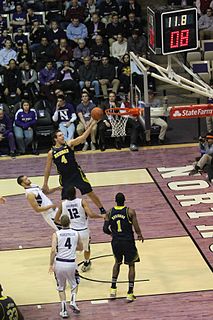Related Research Articles

Basketball is a team sport in which two teams, most commonly of five players each, opposing one another on a rectangular court, compete with the primary objective of shooting a basketball through the defender's hoop while preventing the opposing team from shooting through their own hoop. A field goal is worth two points, unless made from behind the three-point line, when it is worth three. After a foul, timed play stops and the player fouled or designated to shoot a technical foul is given one, two or three one-point free throws. The team with the most points at the end of the game wins, but if regulation play expires with the score tied, an additional period of play (overtime) is mandated.

In basketball, the basketball court is the playing surface, consisting of a rectangular floor, with baskets at each end. Indoor basketball courts are almost always made of polished wood, usually maple, with 3.048 metres (10.00 ft)-high rims on each basket. Outdoor surfaces are generally made from standard paving materials such as concrete or asphalt.
In basketball, a technical foul is any infraction of the rules penalized as a foul which does not involve physical contact during the course of play between opposing players on the court, or is a foul by a non-player. The most common technical foul is for unsportsmanlike conduct. Technical fouls can be assessed against players, bench personnel, the entire team, or even the crowd. These fouls, and their penalties, are more serious than a personal foul, but not necessarily as serious as a flagrant foul.

A shot clock is a countdown timer used in basketball that provides a set amount of time that a team may possess the ball before attempting to score a field goal. It is distinct from the game clock, which displays the time remaining in the period of play. It may be colloquially known as the 24-second clock, particularly in the NBA and other leagues where that is the duration of the shot clock. If the shot clock reaches zero before the team attempts a field goal, the team has committed a shot clock violation, which is penalized with a loss of possession.

In basketball, free throws or foul shots are unopposed attempts to score points by shooting from behind the free throw line, a line situated at the end of the restricted area. Free throws are generally awarded after a foul on the shooter by the opposing team, analogous to penalty shots in other team sports. Free throws are also awarded in other situations, including technical fouls, and when the fouling team has entered the bonus/penalty situation. Also, depending on the situation, a player may be awarded between one and three free throws. Each successful free throw is worth one point.

In basketball, a personal foul is a breach of the rules that concerns illegal personal contact with an opponent. It is the most common type of foul in basketball. A player fouls out on reaching a limit on personal fouls for the game and is disqualified from participation in the remainder of the game.

Streetball is a variation of basketball, typically played on outdoor courts and featuring significantly less formal structure and enforcement of the game's rules. As such, its format is more conducive to allowing players to publicly showcase their own individual skills. Streetball may also refer to other urban sports played on asphalt. It is particularly popular and important in New York City, though its popularity has spread across the United States due to the game's adaptability.
In sports, a time-out or timeout is a halt in the play. This allows the coaches of either team to communicate with the team, e.g., to determine strategy or inspire morale, as well as to stop the game clock. Time-outs are usually called by coaches or players, although for some sports, TV timeouts are called to allow media to air commercial breaks. Teams usually call timeouts at strategically important points in the match, or to avoid the team being called for a delay of game-type violation, such as the five-second rule in basketball.

The rules of basketball are the rules and regulations that govern the play, officiating, equipment and procedures of basketball. While many of the basic rules are uniform throughout the world, variations do exist. Most leagues or governing bodies in North America, the most important of which are the National Basketball Association and NCAA, formulate their own rules. In addition, the Technical Commission of the International Basketball Federation (FIBA) determines rules for international play; most leagues outside North America use the complete FIBA ruleset.
In basketball, traveling is a violation of the rules that occurs when a player holding the ball moves one or both their feet illegally. Traveling is also called, predominantly in a streetball game, "walking" or "steps". If the pivot foot is lifted, a pass or try for made basket must be made before the pivot foot is replaced to the floor. In the NBA and FIBA, players are also given a "gather step".
In sports, running out the clock is the practice of a winning team allowing the clock to expire through a series of pre-selected plays, either to preserve a lead or hasten the end of a one-sided contest. Such measures expend time, but do not otherwise have a tactical purpose. This is usually done by a team that is winning by a slim margin near the end of a game, in order to reduce the time available for the opposing team to score. Generally, it is the opposite strategy of running up the score.

This glossary of basketball terms is a list of definitions of terms used in the game of basketball. Like any other major sport, basketball features its own extensive vocabulary of unique words and phrases used by players, coaches, sports journalists, commentators, and fans.
The Trent Tucker Rule is a basketball rule that disallows any regular shot to be taken on the court if the ball is put into play with under 0.3 seconds left in game or shot clock. The rule was adopted in the 1990–91 season and named after New York Knicks player Trent Tucker, and officially adopted in FIBA play starting in 2010. When the WNBA was established in 1997, this rule was adopted too.
In basketball, the five-second rule, or five-second violation, is a rule that helps promote continuous play. There are multiple situations where a five-second violation may occur.
Delay of game is an action in a sports game in which a player or team deliberately stalls the game, usually with the intention of using the delay to its advantage. In some sports, the delay of game is considered an infraction if it is longer than that permitted according to the game's rules, in which case a penalty can be issued. Some sports that have a delay of game penalty are American football, Canadian football, ice hockey and association football.

The key, officially referred to as the free throw lane by the National Basketball Association (NBA), the National Collegiate Athletic Association (NCAA), and the National Association of Intercollegiate Athletics (NAIA), the restricted area by the international governing body FIBA, and colloquially as the lane or the paint, is a marked area on a basketball court surrounding the basket. It is bounded by the endline, the free-throw line and two side lines, and usually painted in a distinctive color. It is a crucial area on the court where much of the game's action takes place.
Basketball is a ball game and team sport in which two teams of five players try to score points by throwing or "shooting" a ball through the top of a basketball hoop while following a set of rules. Since being developed by James Naismith as a non-contact game that almost anyone can play, basketball has undergone many different rule variations, eventually evolving into the NBA-style game known today. Basketball is one of the most popular and widely viewed sports in the world.

3x3 basketball is a variation of basketball played three-a-side, with one backboard and in a half-court setup. According to an ESSEC Business School study commissioned by the International Olympic Committee, 3x3 is the largest urban team sport in the world. This basketball game format is currently being promoted and structured by FIBA, the sport's governing body. Its primary competition is an annual FIBA 3X3 World Tour, comprising a series of Masters and one Final tournament, and awarding six-figure prize money in US dollars. The FIBA 3x3 World Cups for men and women are the highest tournaments for national 3x3 teams. The 3x3 format has been adopted for both the 2020 Summer Olympics and 2022 Commonwealth Games.
In basketball, a common violation is the most minor class of illegal action. Most violations are committed by the team with possession of the ball, when a player mishandles the ball or makes an illegal move. The typical penalty for a violation is loss of the ball to the other team. This is one type of turnover.

Big3 is a 3-on-3 basketball league founded by hip hop musician and actor Ice Cube and entertainment executive Jeff Kwatinetz. The league consists of 12 teams whose rosters include both former NBA players and international players. The rules enforced in Big3 games contain major deviations from the official rules of 3-on-3 basketball as administered by FIBA. In January 2020, Big3 announced its rule set would be the core of a new basketball variant called "Fireball3".
References
- ↑ Johnson, Greg (November 5, 2013). "Women's basketball puts 10-second backcourt rule in effect for first time". NCAA. Retrieved January 18, 2014.
